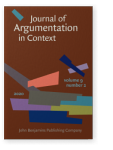Vol. 9:2 (2020) ► pp.219–242
A Dutch dose of dissent
Exploring the role of gender, education, and culture on Dutch students’ argumentative predispositions
The Dutch are often thought of as direct, verbally aggressive, and argumentative. Yet, evidence for this stereotype is lacking. This study explores argumentative predispositions in the Netherlands. In a survey, Dutch students’ (N = 133) argumentativeness, verbal aggressiveness, argument frames, and conflict personalization were measured. The effects of gender and education were assessed. To explore the role of Dutch culture on argumentativeness, comparisons to U.S. students (benchmark) were made. Overall, Dutch students showed orientations, expectations, and understandings of argumentation as being useful and enjoyable, and seemed to experience argumentation predominantly positive. Males were more aggressive than females, and students in higher professional and university (preparatory) education were more constructive than students in vocational education. In contrast to expectations, Dutch students did not appear more predisposed to argue than U.S. students. Dutch students prioritized prosocial behaviors and professional reflection, thereby tempering aggression in arguing. Thus, argumentativeness is certainly not merely (stereo)typically Dutch.
Article outline
- 1.Introduction
- 2.Methods
- 2.1Participants
- 2.2Procedure
- 2.3Measurements
- Socio-demographic variables
- Argumentativeness
- Verbal aggressiveness
- Argument frames
- Taking conflict personally
- Socio-demographic variables
- 2.4Analysis
- 3.Results
- 3.1Scale reliability and validity
- 3.2Dutch students’ argumentative predispositions
- 3.3Gender and argumentative predispositions
- 3.4Educational level and argumentative predispositions
- 3.5A comparison between Dutch students’ and U.S. students’ argumentative predispositions
- 4.Discussion
- 4.1Discussion
- 4.2Strengths and limitations
- 4.3Implications
- 5.Conclusion
- Acknowledgements
- Note
-
References
